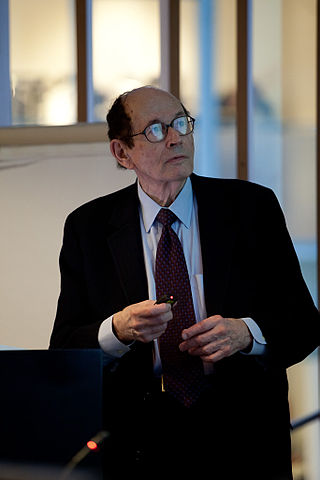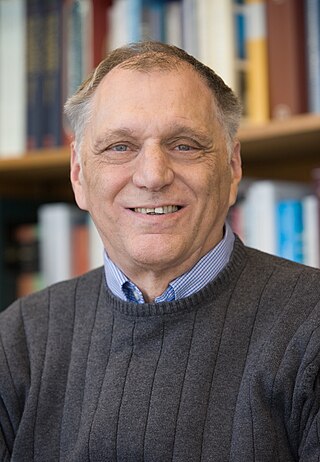
Neural Darwinism is a biological, and more specifically Darwinian and selectionist, approach to understanding global brain function, originally proposed by American biologist, researcher and Nobel-Prize recipient Gerald Maurice Edelman. Edelman's 1987 book Neural Darwinism introduced the public to the theory of neuronal group selection (TNGS), a theory that attempts to explain global brain function.

Dopaminergic pathways in the human brain are involved in both physiological and behavioral processes including movement, cognition, executive functions, reward, motivation, and neuroendocrine control. Each pathway is a set of projection neurons, consisting of individual dopaminergic neurons.
Cortical maps are collections (areas) of minicolumns in the brain cortex that have been identified as performing a specific information processing function.

The auditory cortex is the part of the temporal lobe that processes auditory information in humans and many other vertebrates. It is a part of the auditory system, performing basic and higher functions in hearing, such as possible relations to language switching. It is located bilaterally, roughly at the upper sides of the temporal lobes – in humans, curving down and onto the medial surface, on the superior temporal plane, within the lateral sulcus and comprising parts of the transverse temporal gyri, and the superior temporal gyrus, including the planum polare and planum temporale.

Stephen Grossberg is a cognitive scientist, theoretical and computational psychologist, neuroscientist, mathematician, biomedical engineer, and neuromorphic technologist. He is the Wang Professor of Cognitive and Neural Systems and a Professor Emeritus of Mathematics & Statistics, Psychological & Brain Sciences, and Biomedical Engineering at Boston University.
Mriganka Sur is an Indian neuroscientist. He is the Newton Professor of Neuroscience and Director of the Simons Center for the Social Brain at the Massachusetts Institute of Technology. He is also a visiting faculty member in the Department of Computer Science and Engineering at the Indian Institute of Technology Madras and N.R. Narayana Murthy Distinguished Chair in Computational Brain Research at the Centre for Computational Brain Research, IIT Madras. He was on the Life Sciences jury for the Infosys Prize in 2010 and has been serving as jury chair from 2018.
In neuroscience, homeostatic plasticity refers to the capacity of neurons to regulate their own excitability relative to network activity. The term homeostatic plasticity derives from two opposing concepts: 'homeostatic' and plasticity, thus homeostatic plasticity means "staying the same through change". In the nervous system, neurons must be able to evolve with the development of their constantly changing environment while simultaneously staying the same amidst this change. This stability is important for neurons to maintain their activity and functionality to prevent neurons from carcinogenesis. At the same time, neurons need to have flexibility to adapt to changes and make connections to cope with the ever-changing environment of a developing nervous system.
The Richard Lounsbery Award is given to American and French scientists, 45 years or younger, in recognition of "extraordinary scientific achievement in biology and medicine."
Activity-dependent plasticity is a form of functional and structural neuroplasticity that arises from the use of cognitive functions and personal experience. Hence, it is the biological basis for learning and the formation of new memories. Activity-dependent plasticity is a form of neuroplasticity that arises from intrinsic or endogenous activity, as opposed to forms of neuroplasticity that arise from extrinsic or exogenous factors, such as electrical brain stimulation- or drug-induced neuroplasticity. The brain's ability to remodel itself forms the basis of the brain's capacity to retain memories, improve motor function, and enhance comprehension and speech amongst other things. It is this trait to retain and form memories that is associated with neural plasticity and therefore many of the functions individuals perform on a daily basis. This plasticity occurs as a result of changes in gene expression which are triggered by signaling cascades that are activated by various signaling molecules during increased neuronal activity.

Larry Ryan Squire is an American psychiatrist and neuroscientist. He is a professor of psychiatry, neurosciences, and psychology at the University of California, San Diego, and a Senior Research Career Scientist at the Veterans Affairs Medical Center, San Diego. He is a leading investigator of the neurological bases of memory, which he studies using animal models and human patients with memory impairment.
Malleability of intelligence describes the processes by which intelligence can increase or decrease over time and is not static. These changes may come as a result of genetics, pharmacological factors, psychological factors, behavior, or environmental conditions. Malleable intelligence may refer to changes in cognitive skills, memory, reasoning, or muscle memory related motor skills. In general, the majority of changes in human intelligence occur at either the onset of development, during the critical period, or during old age.
The Troland Research Awards are an annual prize given by the United States National Academy of Sciences to two researchers in recognition of psychological research on the relationship between consciousness and the physical world. The areas where these award funds are to be spent include but are not limited to areas of experimental psychology, the topics of sensation, perception, motivation, emotion, learning, memory, cognition, language, and action. The award preference is given to experimental work with a quantitative approach or experimental research seeking physiological explanations.
William Thomas Newsome is a neuroscientist at Stanford University who works to "understand the neuronal processes that mediate visual perception and visually guided behavior." He is a member of the National Academy of Sciences.

David Poeppel is Professor of Psychology and Neural Science at New York University (NYU). From 2014 until the end of 2021, he was the Director of the Department of Neuroscience at Max Planck Institute for Empirical Aesthetics (MPIEA). In 2019, he co-founded the Center for Language, Music and Emotion (CLaME) an international joint research center, co-sponsored by the Max Planck Society and New York University. Since 2021, he is the managing director of the Ernst Strüngmann Institute.
The Karl Spencer Lashley Award is awarded by The American Philosophical Society as a recognition of research on the integrative neuroscience of behavior. The award was established in 1957 by a gift from Dr. Karl Spencer Lashley.
The following outline is provided as an overview of and topical guide to the human brain:
Mortimer Mishkin was an American neuropsychologist, and winner of the 2009 National Medal of Science awarded in Behavior and Social Science.
Bryan Edward Kolb is a Canadian neuroscientist, neuropsychologist, researcher, author and educator. Kolb's research focuses on the organization and functions of the cerebral cortex.
The IBRO Dargut and Milena Kemali International Prize for Research in the field of Basic and Clinical Neurosciences' is a prize awarded every two years to an outstanding researcher, under 45 years old, who made important contributions in the field of Basic and Clinical Neurosciences. The award was established in 1998.





